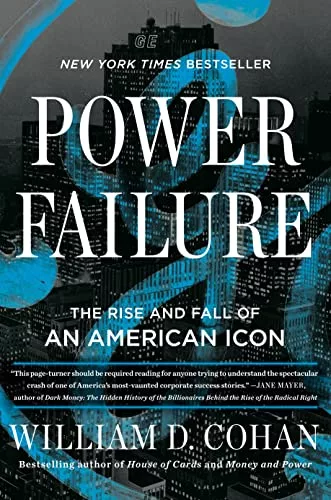Power Failure: The Rise and Fall of an American Icon by William D. Cohan is a large book about the success and failures of General Electric. Cohan takes readers behind the scenes from the start of GE to today. “Beginning with its founding, innovations, and exponential growth through acquisitions and mergers, Cohan plumbs the depths of GE’s storied management culture, its pioneering doctrine of shareholder value, and its seemingly hidden blind spots, to reveal that GE wasn’t immune from the hubris and avoidable mistakes suffered by many other corporations.”
Pairs With: a Twix because it’s made by Mars Wrigley which is another massive corporation almost everyone is familiar with.
Overview

Power Failure: The Rise and Fall of an American Icon by William D Cohan is a large book about the success and failures of General Electric. Cohan takes readers behind the scenes from the start of GE to today. This book is for anyone who is interested in learning about big business and corporate leadership. There is a lot to learn from how GE transitioned itself through the decades from its beginning in Schenectady, NY in 1892 to Boston, MA today.
Don’t read this book if you hope to walk away with one reason why GE collapsed. You will quickly discover that there is instead a lot of finger-pointing by past executives and that the demise was more complex than one issue.
The Bank of GE
Did you know that GE created a giant unregulated bank called GE Capital? Yeah, neither did I! But that’s how GE wanted it. With GE’s prized AAA-rated credit, they were able to borrow money for cheap and then turn around and loan it out for much more. They did this while expressing to shareholders their value as an industrial company. However, by 2003 GE Capital was “providing more than half of GE’s pretax net income. It’s fair to say that without the profits that GE Capital was churning out year after year, Jack [Welch] would never have been named Fortune’s ‘Manager of the Century’ and GE would never have become the world’s most valuable company.” Cohan does a great job of explaining complex topics. Such as, how GE Capital came about and how Jack Welch continued to grow (and use) that sector as it became a majority of GE’s business.
Corporate Politics at the Executive Level
Surprisingly, Cohan was able to interview a lot of prior executives. Some remained anonymous while others felt comfortable going on the record. In fact, Power Failure starts out with William Cohan interviewing Jack Welch at a golf course in Nantucket. I didn’t realize it at the time but this first chapter sets the tone and expectations for the whole book. Welch candidly expresses how upset he was with his predecessor Jeff Immelt as CEO.
Cohan then takes the readers back to the start of GE. Where Thomas Edison wasn’t too eager to merge “Edison General Electric Company” with Charles Coffin’s “Thomson-Houston.” It appears that tainted energy prevailed throughout the company’s life. Cohan does a fantastic job of digging into the drama and corporate politics behind GE all the way back to the start of the company.
Conclusion

If you’re someone who is interested in business and isn’t intimidated by large books then this one is for you. Whether it’s studying Jack Welch’s tactics as CEO or learning about how businesses pivot when faced with adversity, there is a lot to learn in this one. From leadership to corporate politics to mergers, divestitures and SEC accounting, this book has it all when it comes to big business. Cohan does a nice job of demonstrating how large GE truly was and breaks down what events impacted its success. He also did a fantastic job of remaining unbiased. For example, I don’t know who is to blame for GE’s demise. It didn’t appear to be any one person’s doing. Cohan was able to interview incredible sources such as Jack Welch, Jeff Immelt, and others. He asked them directly why they made the choices they made and allowed them to share their perspective.
One last thing, this book is largely focused on the men who ran GE. Occasionally a wife will be referenced but that’s usually due to a divorce or an affair. As one reviewer on Amazon mentioned, it would be interesting to hear from the children’s perspective whose fathers were GE executives. Besides Immelt’s trip with his daughter, most of the men appeared to put GE above all else.
PS If you enjoyed this one you might also like The Man Who Solved the Market by Gregory Zuckerman! Jim Simons is a bit more mysterious than Welch or Immelt but it’s another great story!!



